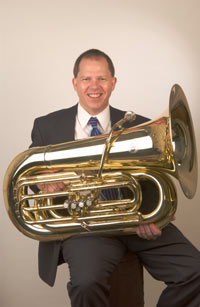

|
TUBA TIPS FOR PLAYERS & STUDENTS - From NorlanBewley.com "The 3 Tuba Mouthpiece Placements" There are three tuba mouthpiece placements. All are correct, you just have to use the one that is correct for you. Most tuba players naturally find the right one, but sometimes they are told to use the wrong one. Teachers tend to think theirs is the only one, which is easy to understand because that's what they know works for them. 1) High Placement: 2) Low Placement: As your lips slide down your teeth and your vocal breath goes higher in your throat, the air stream bends up more as you ascend. It bends back towards straighter as you go lower. The jaw tends to be out (or forward) for this placement. Also called Up Stream Placement. 3) Center Placement: ~ ~ ~ ~ ~ Just because a famous tuba player has a particular placement doesn't make it common or the one for you. Check and see which one you have. You can usually tell quickly. Your goal is to sing the sound in your mind and have it come out of your horn. To me, brass playing is a substitute for singing, using your horn in place of your voice. Mouthpiece maker Doug Elliott has a great article on embouchure types and mouthpieces here:
Also of interest would be David Wilken's quite detailed article on the three basic brass embouchure types: I find that this applies equally to euphonium and tuba as well as trombone. Copyright Norlan Bewley 1999
|
 |
 |
 |
 |
| Biography | Online Music Store | Low Brass Ensemble | Instruments | mp3 Sounds | Bewley Music | FAQ | Low Brass Tips | Sheet Music |
